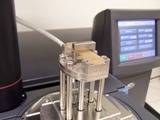CIC Expands Its Capabilities
In support of its industry and research partners the Composites Innovation Centre (CIC) has been steadily expanding its capabilities. Several key equipment acquisitions have been made recently that include a filament winding machine, a modulated differential scanning calorimeter (DSC), a dynamic mechanical analyzer (DMA) and a small numerically controlled (NC) machining centre. “These acquisitions are timed to meet immediate and long term needs of our project collaborators”, says Sean McKay, Executive Director, “and are also complementary to local industrial and research infrastructure”. The filament winding machine is capable of producing parts that are 30 feet long and 60 in. in diameter. It is being set up in collaboration with the University of Manitoba to produce a prototype 80 m tall composite lattice tower, a technology that is being developed by Dr. Dimos Polyzois and his colleagues within the Faculty of Civil Engineering. With the DSC and DMA analytical equipment, it enables in depth assessments of critical composite material properties to determine if they are capable of meeting in-service conditions. In some instances, they can be used as investigative tools to assess failed parts to see if they have been manufactured properly. The machining centre enables the CIC to produce test specimens to the high tolerances required by test specifications and supports rapid prototyping. Please contact us at CIC@compositsinnovation.ca if you think that these new capabilities may be of assistance to you or you would like additional information.
Do Natural Fibres in Composite Parts Make Economic Sense?
It has always been considered that if natural fibres were going to be used as reinforcements in composite parts, it would lead to additional revenues for the farm community and to the development of new, profitable businesses processing these fibres. Over several years our European counterparts have been exploiting the use of biofibres in thermoplastic parts for automotive applications to meet weight, impact and recyclability restrictions; however, what’s new is the idea that this concept could be profitable in Canada. As part of its Biofibres Initiative, the CIC recently performed a study that assessed the financial viability of producing and processing agricultural fibres from oil seed flax and industrially grown hemp. The costs for gathering and processing the fibres, using several techniques, were determined and compared against current prices for traditional fiberglass reinforcement materials being manufactured in both North America and Asia. Alternate business models were examined and it was determined that, in most cases, there were good returns to be made. “There’s a huge potential for a processor to commercialize here in Canada” said Mercedes Alcock, Bio-Composites Project Leader, after compiling the data and completing the report, “Manitoba in particular is in a great position to capitalize on this opportunity as it has both the acres and the industry to support a venture.”
Member Services To Grow
CIC’s member services are about to grow as we move into our second membership year. This expansion includes launching of a member’s only area on our website that will contain a materials and process selection matrix as an initial offering. This interactive tool is useful to product developers for improving their designs by providing access to the latest in materials, their properties and manufacturing processes. In addition, we are developing proposals to support further Special Interest Group (SIG) activities and Technology and Trade Missions to both North American and European destinations.
